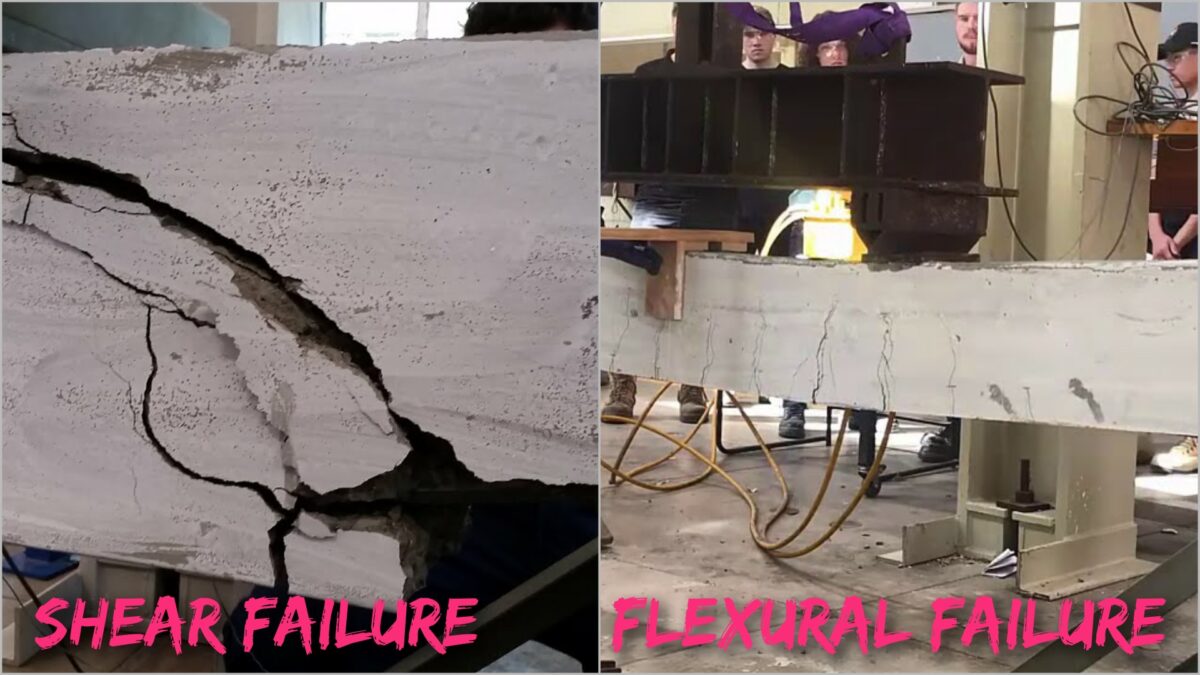This article explains various types of failures in beams.
Failure of a single structural member can lead to complete structural collapse. That is why we need to identify all types of failures in the beam.
There are two types of failures in beams.
- Flexural failure
- Shear failure
Flexural failure occurs due to imposed load exceeding the flexural capacity of the materials of the beam.
Shear failure occurs due to a deficiency in shear resistance between different materials of the beam.

Table of Contents
Flexural Failures
Flexural failure is divided into three types.
(I) Flexural Tension Failure
(II) Flexural Compression Failure
(III) Balanced Failure
Detailed descriptions are as follows.
(I) Flexural Tension Failure
Flexural tension failure starts by yielding steel reinforcement followed by the crushing of concrete at the compression side of the beam. It happens when the beam is under-reinforced; the reinforcement ratio in the beam is low than the balanced reinforced ratio according to ACI 318-14.
(II)Flexural Compression Failure
The flexural compression failure starts by crushing of concrete at the compression side followed by the yielding of steel at the tension side of the beam. It happens when the beam is over-reinforced which means the beam reinforcement ratio is greater than the balanced reinforcement ratio according to ACI 318-14.
(III) Balanced Failure
This type of failure in when concrete crushes and steel yields at the same time. It happens when the amount of steel in the beam is equal to the balanced reinforcement ratio according to ACI 318-14.
Shear Failures
Flexural failure is divided into four types.
(I) Diagonal Tension Failure
Diagonal tension failure starts with the development of vertical cracks or flexural cracks at the bottom of the beam due to flexural tensile stress. Then, as the load on the beam increases, these cracks grow both in width and length and bend in a diagonal direction as it moves to the upper part of the beam toward the loading point. After that, the last stage of shear tension failure occurs which is a sudden failure of concrete in shear.
(II) Shear Compression Failure
Shear compression failure starts with the initiation and development of cracks in the beam cross-section. Then, these cracks propagate and penetrate the compression zone of the beam, and the final stage of the failure occurs when the compressive strength of the concrete is exceeded.
(III) Splitting Shear (True Shear) Failure
When the shear span to depth ratio of a beam is less than one, splitting shear failure can be habitual. This type of beam is known as a deep beam in which loads are directly transferred to supports, and shear strength is much more than in ordinary flexural beams.
(IV) Anchorage failure
Anchorage failure is the splitting of concrete along with the longitudinal reinforcement before compression failure due to small diagonal cracks. It happens when the primary reinforcement is not sufficiently anchored beyond the crack.
